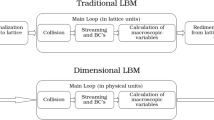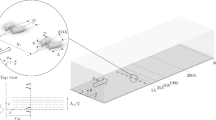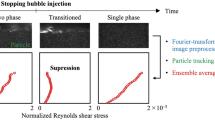Abstract
This paper describes in detail a numerical scheme to predict complex turbulent flows using a recent model based on temporal large-eddy simulations (TLES). To solve the equations a second-order finite volume numerical method coupled with a second-order time integration scheme is used. The numerical scheme is validated and then applied to present new results concerning the prediction of the complex turbulent flow in a cubic lid-driven cavity, at Reynolds numbers \(Re=12{,}000\) and \(Re=18{,}000\). The results obtained with the TLES are compared with direct numerical simulations and experimental data for the mean velocity flow field and for the Reynolds stresses, showing to be very attractive when compared to large-eddy simulations.



















Similar content being viewed by others
References
Watson E (1964) The radial spread of a liquid jet over a horizontal plane. J Fluid Mech 20:481–499
Tang Z, Wan D (2015) Numerical simulation of impinging jet flows by modified MPS method. Eng Comput 32:1153–1171
Bhajantri M, Eldho T, Deolalikar P (2007) Numerical modelling of turbulent flow through spillway with gated operation. Int J Numer Methods Eng 72:221–243
Fureby C (2009) Large eddy simulation modelling of combustion for propulsion applications. Phil Trans Roy Soc Lond A—Math Phys Eng Sci 367:2957–2969
Menzies K (2009) Large eddy simulation applications in gas turbines. Phil Trans Roy Soc Lond A—Math Phys Eng Sci 367:2827–2838
Eastwood S, Tucker P, Xia H, Klostermeier C (2009) Developing large eddy simulation for turbomachinery applications. Phil Trans Roy Soc Lond A—Math Phys Eng Sci 367:2999–3013
Bouffanais R (2010) Advances and challenges of applied large-eddy simulation. Comput Fluids 39:735–738
Bouffanais R, Deville M, Fischer M, Leriche E, Weill D (2006) Large-eddy simulation of the lid-driven cubic cavity flow by the spectral element method. J Sci Comput 27:151–162
Pruett C, Gatski T, Grosch C, Thacker W (2003) The temporally filtered Navier–Stokes equations: properties of the residual stress. Phys Fluids 15:2127
Berland J, Lafon P, Daude F, Crouzet F, Bogey C, Bailly C (2011) Filter shape dependence and effective scale separation in large-eddy simulations based on relaxation filtering. Comput Fluids 47:65–74
Arai J, Koshizuka S, Murozono K (2013) Large eddy simulation and a simple wall model for turbulent flow calculation by a particle method. Int J Numer Methods Fluids 71:772–787
Tsang C, Trujillo M, Rutland C (2014) Large-eddy simulation of shear flows and high-speed vaporizing liquid fuel sprays. Comput Fluids 105:262–279
Sagaut P (2006) Large eddy simulation for incompressible flows—an introduction. Springer, Berlin
Frisch U (1995) Turbulence. Cambridge University Press, Cambridge
Pruett C (2008) Temporal large-eddy simulation: theory and implementation. Theor Comput Fluid Dyn 22:275–304
Dakhoul Y, Bedford K (1986) Improved averaging method for turbulent flow simulation. Part I: theoretical development and application to Burgers’ transport equation. Int J Numer Methods Fluids 6:49
Aldama A (1990) Filtering techniques for turbulent flow simulation. Lectures notes in engineering. Springer, Berlin
Meneveau C, Lund T, Cabot W (1996) Lagrangian dynamic subgrid-scale model of turbulence. J Fluid Mech 319:353–385
Pruett CD (2000) Eulerian time-domain filtering for spatial large-eddy simulation. AIAA 38(9):1634–1642
Stolz S, Adams N (1999) An approximate deconvolution procedure for large-eddy simulation. Phys of Fluids 11(7):1699–1701
Tejada-Martínez A, Grosch C, Gatski T (2007) Temporal large-eddy simulation of unstratified and stably stratified turbulent channel flows. Int J Heat Fluid Flow 28:1244–1261
Leriche E, Gavrilakis S (2000) Direct numerical simulation of the flow in a lid-driven cubical cavity. Phys Fluids 12:1363
Bruneau C, Saad M (2006) The 2D lid-driven cavity problem revisited. Comput Fluids 35:326–348
Thais L, Tejada-Martínez A, Gatski T, Mompean G (2010) Temporal large eddy simulations of turbulent viscoelastic drag reduction flows. Phys Fluids 22(013):103
Pruett C, Thomas B, Grosch C, Gatski T (2006) A temporal approximate deconvolution model for large-eddy simulation. Phys Fluids 18(028):104
Bell JB, Colella P, Glaz HM (1989) A 2nd-order projection method for the incompressible Navier–Stokes equations. J Comp Phys 85(2):257–283
Liu M, Ren YX, Zhang H (2004) A class of fully second order accurate projection methods for solving the incompressible Navier–Stokes equations. J Comp Phys 200(1):325–346
Guermond JL, Minev P, Shen J (2006) An overview of projection methods for incompressible flows. Comput Method Appl M 195(44–47):6011–6045
Sousa FS, Oishi CM, Buscaglia GC (2015) Spurious transients of projection methods in microflow simulations. Comput Method Appl M 285:659–693
Perot JB (1993) An analysis of the fractional step method. J Comput Phys 108(1):51–58
Strikwerda JC, Lee YS (1999) The accuracy of the fractional step method. SIAM J Numer Anal 37(1):37–47
Codina R (2001) Pressure stability in fractional step finite element methods for incompressible flows. J Comput Phys 170(1):112–140
Armfield S, Street R (2002) An analysis and comparison of the time accuracy of fractional-step methods for the Navier–Stokes equations on staggered grids. Int J Numer Methods Fluids 38(3):255–282
Gervasio P, Saleri F (2006) Algebraic fractional-step schemes for time-dependent incompressible Navier–Stokes equations. J Sci Comput 27(1–3):257–269
Chorin A (1968) Numerical solution of the Navier–Stokes equations. Math Comp 22:745–762
Leonard B (1979) A stable and accurate convective modelling procedure base and quadratic upstream interpolation. Comput Methods Appl Mech Eng 19:59–98
Harris J, Grilli S (2011) A perturbation approach to large eddy simulation of wave-induced bottom boundary layer flows. Int J Numer Methods Fluids 68:1574–1604
Hirt CW, Nichols BD, Romero NC (1975) SOLA numerical solution algorithm for transient fluid flow. Los Alamos Laboratory, Report LA-5852
Peric M, Kessler R, Scheuerer G (1988) Comparison of finite-volume numerical-methods with staggered and colocated grids. Comput Fluids 16(4):389–403
Piller M, Stalio E (2004) Finite-volume compact schemes on staggered grids. J Comput Phys 197(1):299–340
Fletcher R (1976) Conjugate gradient methods for indefinite systems. In: Watson GA (ed) Numerical analysis. Lecture notes in mathematics, vol 506. Springer, Berlin
Kremer F, Bogey C (2015) Large-eddy simulation of turbulent channel flow using relaxation filtering: resolution requirement and Reynolds number effects. Comput Fluids 116:17–28
Deardorff J (1970) A numerical study of three-dimensional turbulent channel flow at large Reynolds numbers. J Fluid Mech 41:453–480
Kim J, Moin P, Moser R (1987) Turbulence statistics in fully developed channel flow at low Reynolds number. J Fluid Mech 177:133–166
Moser R, Kim J, Mansour N (1999) Direct numerical simulation of turbulent channel flow up to \({R}e_{\tau }\)=590. Phys Fluids 11(4):943–945
Thais L, Tejada-Martínez A, Gatski T, Mompean G (2011) A massively parallel hybrid scheme for direct numerical simulation of turbulent viscoelastic channel flow. Comput Fluids 43:134–142
Tabor G, Baba-Ahmadi M (2010) Inlet conditions for large eddy simulation: a review. Comput Fluids 39:553–567
Corrêa L (2016) Simulação de grandes escalas de escoamentos turbulentos com filtragem temporal via método de volumes finitos. Ph.D. thesis, University of São Paulo
Koseff J, Street R (1984) The lid-driven cavity flow: a synthesis of qualitative and quantitative observations. J Fluids Eng 106:390–398
Jordan S, Ragab S (1994) On the unsteady and turbulent characteristics of the three-dimensional shear-driven cavity flow. J Fluids Eng 116:439–449
Shankar P, Desphande M (2000) Fluid mechanics in the driven cavity. Annu Rev Fluid Mech 32:93–136
Kawaguti M (1961) Numerical solution of the Navier–Stokes equations for the flow in a two dimensional cavity. J Phys Soc Japan 16:2307–2327
Burggraf O (1966) Analytical and numerical studies of the structure of steady separated flows. J Fluid Mech 24:113–151
Ghia U, Ghia K, Shin C (1982) High-resolutions for incompressible flow using the Navier–Stokes equations and a multigrid method. J Comput Phys 48:387–411
Shetty D, Fisher T, Chunekar A, Frankel S (2010) High-order incompressible large-eddy simulation of fully inhomogeneous turbulent flows. J Comp Phys 229:8802–8822
Vreman A (2004) An eddy-viscosity subgrid-scale model for turbulent shear flow: algebraic theory and applications. Phys Fluids 16:3670–3681
Paraview (2013) Paraview / Line Integral Convolution. URL http://www.paraview.org/Wiki/ParaView/Line_Integral_Convolution. Accessed 03 Dec 2015
Acknowledgements
We gratefully acknowledge the support provided by FAPESP (Grants 2010/16865-2, 2012/17827-2 and 2015/02649-0).
Author information
Authors and Affiliations
Corresponding author
Additional information
Technical Editor: Jader Barbosa Jr.
Rights and permissions
About this article
Cite this article
Corrêa, L., Mompean, G., Kurokawa, F.A. et al. Temporal large-eddy simulations of the lid-driven cavity by finite volume method. J Braz. Soc. Mech. Sci. Eng. 40, 417 (2018). https://doi.org/10.1007/s40430-018-1333-z
Received:
Accepted:
Published:
DOI: https://doi.org/10.1007/s40430-018-1333-z




